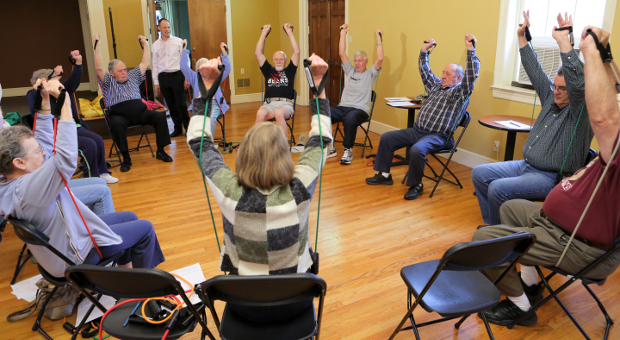The Medical Minute: Maintaining strength is key to older adults functioning independently

Although people of any age can benefit from regular strength training, it becomes especially important for those in middle age and beyond. That’s when muscle fiber begins to break down at a rate of about one pound per year.
“When you lose enough muscle, you aren't able to do things you used to be able to do,” says Dr. Christopher Sciamanna, chief of internal medicine at Penn State Milton S. Hershey Medical Center. Things like walking, lifting and carrying groceries, pushing a vacuum cleaner or pulling a piece of furniture become more difficult as muscle is lost.
That's why, one year ago, Sciamanna started a program called Band Together, which offers free progressive strength-training classes run by trained volunteers in area churches and community centers. For 40 minutes, twice a week, participants use resistance bands to do shoulder presses, chair stands, pulls, calf raises, bicep curls and chest presses.
Sciamanna began the program because he saw many patients in his primary care practice who didn't exercise their whole lives and were intimidated by the prospect of joining a gym at age 75. “Plus, if you're on a fixed income, you're not joining,” he says.
Although strength training doesn't deliver as much calorie burn or cardiovascular benefit as other types of exercise, Sciamanna says it has been shown to lower blood pressure, blood sugar and relive joint pain. Strengthening muscles also protects bones.
“Muscles cross the joints, so having muscle that is strong and fit usually reduces pain in the joints,” he says. “The stress has to be taken up by something. It can be cartilage, bone or muscle.”
Strength-training exercises are simple, basic moves that anyone can do at home with a set of resistance bands of varying thicknesses and a chair. “If you can do it 15 times, then you want to increase the resistance,” he says. “Your body will get stronger to handle the load.”
Two or three sessions of 30-45 minutes each week are enough for building and maintaining muscle.
Sciamanna says resistance bands are ideal for older adults for many reasons: “They are inexpensive, portable, and if you drop them, nobody gets hurt.”
Many resistance band kits come with DVDs of suggested exercises. Sciamanna says it's more important to focus on larger movements such as standing, pushing forward, pushing up and pulling rather than exercises that may work smaller groups of muscles.
It's also good to start at a moderate pace that feels good. If you haven't been exercising or doing regular strength training, it might be a good idea to get clearance from a doctor before moving on to more vigorous work.
As the Band Together program adds its seventh group, Sciamanna says the feedback he has gotten on the strength training program is great. He frequently hears stories from participants about an ache or pain that has mysteriously disappeared or something they are now able to do that they couldn't beforehand. “There are a lot of functional gains that happen,” he says. “The average 80-year-old can double strength in 12 weeks.”
To see demonstrations of basic strength-training exercises or learn more about the Band Together program, visit www.btpennstate.org.
The Medical Minute is a weekly health news feature brought to you by Penn State Milton S. Hershey Medical Center. Articles feature the expertise of Penn State Hershey faculty physicians and staff, and are designed to offer timely, relevant health information of interest to a broad audience.
If you're having trouble accessing this content, or would like it in another format, please email Penn State Health Marketing & Communications.
